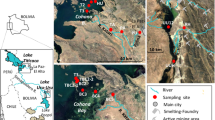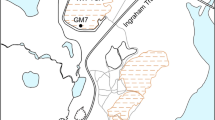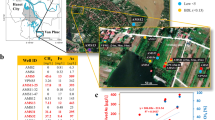Abstract
The contamination of ground waters, abstracted for drinking and irrigation, by sediment-derived arsenic threatens the health of tens of millions of people worldwide, most notably in Bangladesh and West Bengal1,2,3. Despite the calamitous effects on human health arising from the extensive use of arsenic-enriched ground waters in these regions, the mechanisms of arsenic release from sediments remain poorly characterized and are topics of intense international debate4,5,6,7,8. We use a microscosm-based approach to investigate these mechanisms: techniques of microbiology and molecular ecology are used in combination with aqueous and solid phase speciation analysis of arsenic. Here we show that anaerobic metal-reducing bacteria can play a key role in the mobilization of arsenic in sediments collected from a contaminated aquifer in West Bengal. We also show that, for the sediments in this study, arsenic release took place after Fe(iii) reduction, rather than occurring simultaneously. Identification of the critical factors controlling the biogeochemical cycling of arsenic is one important contribution to fully informing the development of effective strategies to manage these and other similar arsenic-rich ground waters worldwide.
This is a preview of subscription content, access via your institution
Access options
Subscribe to this journal
Receive 51 print issues and online access
$199.00 per year
only $3.90 per issue
Buy this article
- Purchase on Springer Link
- Instant access to full article PDF
Prices may be subject to local taxes which are calculated during checkout



Similar content being viewed by others
References
Smith, A. H., Lingas, E. O. & Rahman, M. Contamination of drinking-water by arsenic in Bangladesh: a public health emergency. Bull. WHO 78, 1093–1103 (2000)
Smedley, P. L. & Kinniburgh, D. G. A review of the source, behaviour and distribution of arsenic in natural waters. Appl. Geochem. 17, 517–568 (2002)
Chakraborty, D. et al. Arsenic calamity in the Indian subcontinent. What lessons have been learnt? Talanta 58, 3–22 (2002)
Das, D. et al. Arsenic in groundwater in six districts of West Bengal, India. Environ. Geochem. Health 18, 5–15 (1996)
Chowdhury, T. R. et al. Arsenic poisoning in the Ganges delta. Nature 401, 545–546 (1999)
Nickson, R. et al. Arsenic poisoning of Bangladesh groundwater. Nature 395, 338 (1998)
Nickson, R. T., McArthur, J. M., Ravenscroft, P., Burgess, W. G. & Ahmed, K. M. Mechanism of arsenic release to groundwater, Bangladesh and West Bengal. Appl. Geochem. 15, 403–413 (2000)
Oremland, R. S. & Stolz, J. F. The ecology of arsenic. Science 300, 939–944 (2003)
Harvey, C. F. et al. Arsenic mobility and groundwater extraction in Bangladesh. Science 298, 1602–1606 (2002)
Acharyya, S. K. et al. Arsenic poisoning in the Ganges delta. Nature 401, 545 (1999)
Appelo, C. A. J., Van der Weiden, M. J. J., Tournassat, C. & Charlet, L. Surface complexation of ferrous iron and carbonate on ferrihydrite and the mobilization of arsenic. Environ. Sci. Technol. 36, 3096–3103 (2002)
Chatterjee, D. et al. Mobilization of arsenic in sedimentary aquifer vis-à-vis subsurface iron reduction processes. J. Phys. IV France 107, 293–296 (2003)
Gault, A. G., et al. in Plasma Source Mass Spectrometry: Applications and Emerging Technologies (eds Holland, J. G. & Tanner, S. D.) 112–126 (Royal Society of Chemistry, Cambridge, UK, 2003)
Zobrist, J., Dowdle, P. R., Davis, J. A. & Oremland, R. S. Mobilization of arsenite by dissimilatory reduction of adsorbed arsenate. Environ. Sci. Technol. 34, 4747–4753 (2000)
Gault, A. G., Polya, D. A. & Lythgoe, P. R. in Plasma Source Mass Spectrometry: The New Millennium (eds Holland, G. & Tanner, S. D.) 387–400 (Royal Society of Chemistry, Cambridge, UK, 2001)
Lovley, D. R. & Phillips, E. R. Novel mode of microbial energy metabolism: organic carbon oxidation coupled to dissimilatory reduction of iron or manganese. Appl. Environ. Microbiol. 54, 1472–1480 (1988)
Lovley, D. R. & Chapelle, F. H. Deep subsurface microbial processes. Rev. Geophys. 33, 365–381 (1995)
Gault, A. G. et al. Preliminary EXAFS studies of solid phase speciation of arsenic in a West Bengali sediment. Mineral. Mag. 67, 1183–1191 (2003)
Dixit, S. & Hering, J. G. Comparison of arsenic(V) and arsenic(III) sorption onto iron oxide minerals: Implications for arsenic mobility. Environ. Sci. Technol. 37, 4182–4189 (2003)
Welham, N. J., Malatt, K. A. & Vukcevic, S. The stability of iron phases presently used for disposal from metallurgical systems - a review. Min. Eng. 13, 911–933 (2000)
Bard, A. J., Parsons, R. & Jordan, J. Standard Potentials in Aqueous Solution (Marcel Dekker, New York, 1985)
Ranjard, L. et al. Characterization of bacterial and fungal soil communities by automated ribosomal intergenic spacer analysis fingerprints: Biological and methodological variability. Appl. Environ. Microbiol. 67, 4479–4487 (2001)
Lloyd, J. R. Microbial reduction of metals and radionuclides. FEMS Microbiol. Rev. 27, 411–425 (2003)
Holmes, D. E., Finneran, K. T. & Lovley, D. R. Enrichment of Geobacteraceae associated with stimulation of dissimilatory metal reduction in uranium-contaminated aquifer sediments. Appl. Environ. Microbiol. 68, 2300–2306 (2002)
Teske, A., Alm, E. & Regan, J. M. Evolutionary relationships among ammonia-oxidizing and nitrite-oxidizing bacteria. J. Bacteriol. 176, 6623–6630 (1994)
Kuai, L., Nair, A. A. & Polz, M. F. Rapid and simple method for the most-probable-number estimation of arsenic-reducing bacteria. Appl. Environ. Microbiol. 67, 3168–3173 (2001)
Wenzel, W. W. et al. Arsenic fractionation in soils using an improved sequential extraction procedure. Anal. Chim. Acta 436, 309–323 (2001)
McArthur, J. M., Ravenscroft, P., Safiulla, S. & Thirlwall, M. F. Arsenic in groundwater: testing pollution mechanisms for sedimentary aquifers in Bangladesh. Wat. Resour. Res. 37, 109–117 (2001)
van der Peer, Y. & de Wachter, R. Treecon for windows — a software package for the construction and drawing of evolutionary trees for the Microsoft Windows environment. Comput. Appl. Biosci. 10, 569–570 (2001)
Saitou, N. & Nei, M. The neighbor-joining method; a new method for reconstructing phylogenetic trees. Mol. Biol. Evol. 4, 406–425 (1987)
Acknowledgements
This work was supported by EPSRC, the Bangladesh Ministry of Science & Technology (Bangabandhu Fellowship to F.S.I.), The Royal Society, University of Manchester, ORS, GV Instruments and NERC. H. Rowland is thanked for XRD analysis. R. Bilsborrow and F. Mosselmans provided invaluable support in the acquisition of XAS data, which was supported by beamtime awards at Daresbury SRS by CCLRC. Fieldwork by D.C. was supported by KTH, IFCPAR and the University of Kalyani.
Author information
Authors and Affiliations
Corresponding author
Ethics declarations
Competing interests
The authors declare that they have no competing financial interests.
Supplementary information
Supplementary Information
Gives details of (1) sediment collection methods and characteristics; (2) XAS analysis of unamended sediment and brief interpretation; (3) calculation and brief discussion of relative redox potentials of Fe(III)/Fe(II) and As(V)/As(III) couples and; (4) phylogenetic affiliation of bacteria detected in unamended and amended microcosms. (PDF 350 kb)
Rights and permissions
About this article
Cite this article
Islam, F., Gault, A., Boothman, C. et al. Role of metal-reducing bacteria in arsenic release from Bengal delta sediments. Nature 430, 68–71 (2004). https://doi.org/10.1038/nature02638
Received:
Accepted:
Issue Date:
DOI: https://doi.org/10.1038/nature02638
This article is cited by
-
Occurrence, Species, and Health Effects of Groundwater Arsenic in Typical Rural Areas Along the Northern Foot of the Qinling Mountains, China
Exposure and Health (2024)
-
Sulfate reduction accelerates groundwater arsenic contamination even in aquifers with abundant iron oxides
Nature Water (2023)
-
Environmental implications of spatial and temporal distributions of multiple metallic elements in marginal marine sediments from Eastern Hainan Island, South China Sea
Journal of Soils and Sediments (2023)
-
Machine learning approach for assessment of arsenic levels using physicochemical properties of water, soil, elevation, and land cover
Environmental Monitoring and Assessment (2023)
-
Arsenic Speciation in Rice, Mechanisms and Associated Health Risk Through Rice Consumption in Various Districts of Khyber Pakhtunkhwa, Pakistan
Exposure and Health (2023)
Comments
By submitting a comment you agree to abide by our Terms and Community Guidelines. If you find something abusive or that does not comply with our terms or guidelines please flag it as inappropriate.



